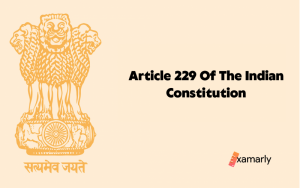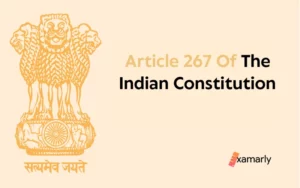An Overview
- An Overview
- Legislative Council
- What Is The Legislative Assembly?
- Article 168 Of The Indian Constitution – In Detail
- Summing Up
- FAQs
- What can be the maximum number of members in a legislative assembly of a state in India?
- What is the upper limit of election expense in a parliamentary constituency?
- In which year, the Metropolitan Council of Delhi was replaced by a 70-member legislative assembly?
- Which among the other states of India does not have a bicameral legislature?
- The power to create or abolish legislative councils in states is vested with which among the following?
- The Andhra Pradesh Legislative Council was abolished in 1985. What year was it reintroduced?
- In which year legislative council of Tamilnadu was abolished?
- Which of the bodies' functions in India are strictly advisory in nature?
- The decisions of the District court are subject to what kind of jurisdiction of the high court?
- If the Government of a State fails to enforce the Directive principles of the state Policy, a citizen can move to which among the following courts to file a writ petition to get them enforced?
- The jurisdiction of Lakshadweep comes under the?
- Andaman and Nicobar Islands' judiciary falls under the supervision of which of the following?
Article 168 of the Indian Constitution talks about the Legislative Structure of the States of Indian Territory.
It talks about how the legislature in the states would look and how different states would have a different structure of the legislature based on some defined parameters for all the states.
Let us dive deep into Article 168 of the Indian Constitution, but before that, we will get familiar with the terms and definitions that are pivotal to the aforementioned article.
All the Articles from Article 153 of the Indian Constitution to Article 163 of the Indian Constitution mention all the aspects related to the lawful presence of the Governor in the State.
Here is the List of the all the Governors of the States of India
| Sl.No. | Name of the State | Name of the Governor |
|---|---|---|
| 01. | Andhra Pradesh | Shri E.S.L.Narasimhan |
| 02. | Arunachal Pradesh | Lt. General(Retd.) Nirbhay Sharma |
| 03. | Assam | Shri J.B.Patnaik |
| 04. | Bihar | Dr. D.Y.Patil |
| 05. | Chhattisgarh | Shri Ram Naresh Yadav |
| 06. | Goa | Shri Bharat Vir Wanchoo |
| 07. | Gujarat | Dr. (Smt.) Kamla |
| 08. | Haryana | Shri Jagannath Pahadia |
| 09. | Himachal Pradesh | Smt. Urmila Singh |
| 10. | Jammu & Kashmir | Shri Narinder Nath Vohra |
| 11. | Jharkhand | Dr. Syed Ahmed |
| 12. | Karnataka | Shri K. Rosaiah |
| 13. | Kerala | Smt. Sheila Dikshit |
| 14. | Madhya Pradesh | Shri Ram Naresh Yadav |
| 15. | Maharashtra | Shri K.Shankaranarayanan |
| 16. | Manipur | Shri Vinod Kumar Duggal |
| 17. | Meghalaya | Dr. Krishan Kant Paul |
| 18. | Mizoram | Shri. Vakkom Purushothaman |
| 19. | Nagaland | Dr. Krishan Kant Paul |
| 20. | Orissa | Shri S.C.Jamir |
| 21. | Punjab | Shri Shivraj V.Patil |
| 22. | Rajasthan | Smt. Margaret Alva |
| 23. | Sikkim | Shri Shriniwas Dadasaheb Patil |
| 24. | Tamil Nadu | Shri K. Rosaiah |
| 25. | Telangana | Shri E.S.L.Narasimhan |
| 26. | Tripura | Shri Vakkom Purushothaman |
| 27. | Uttarakhand | Dr. Aziz Qureshi |
| 28. | Uttar Pradesh | Dr. Aziz Qureshi |
| 29. | West Bengal | Dr. Syed Ahmed |
Legislative Council
The Legislative Council is the name given to the upper chamber of the State Legislature.
The state legislative assembly, as well as other local authorities and organisations, are responsible for electing members of the Legislative Council. The members of the Legislative Council are selected using a process known as indirect election.
The Legislative Council is made up of people who are chosen to serve six-year terms that are spread out over time.
The Chairman of the Legislative Council serves as the body’s presiding official.
In order to be eligible for membership in the Legislative Council, one must be at least 30 years old.
In India, the Legislative Council is only present in six of the country’s states: Andhra Pradesh, Bihar, Karnataka, Maharashtra, and Telangana, along with Uttar Pradesh.
It is recommended that there be a total of three times as many people on this committee as there are total members of the Legislative Assembly. The number of participants must be at least forty and cannot be lower.
Related Articles
Features Of The Legislative Council
- The Legislative Council is the name given to the upper chamber of the State Legislature.
- The state legislative assembly, as well as other local authorities and organisations, are responsible for electing members of the Legislative Council. The members of the Legislative Council are selected using a process known as indirect election.
- Members of the Legislative Council are chosen to serve staggered terms of six years each.
- The Chairman of the Legislative Council serves as the presiding officer of the body.
- In order to be eligible for membership in the Legislative Council, one must be at least 30 years old.
- In India, the Legislative Council is only present in six of the country’s states: Andhra Pradesh, Bihar, Karnataka, Maharashtra, and Telangana, along with Uttar Pradesh.
- It is recommended that there be a total of three times as many people on this committee as there are total members of the Legislative Assembly. The number of participants must be at least forty and cannot be lower.
What Is The Legislative Assembly?
The State Legislative Assembly, often known as the Vidhan Sabha is a legislative body that is present in each of India’s states and union territories.
It functions as the only legislative body in the 28 states and 3 union territories that have a unicameral state legislature, while in the 6 states that have bicameral state legislatures, it serves as the lower house of those legislatures and the State Legislative Council functions as the upper house.
There is no separate legislature for the five union territories, which are instead ruled directly by the central government of India.
Features Of The Legislative Assembly?
- The Legislative Assembly is the name given to the assembly that sits in the lower chamber of the state legislature.
- Members of the Legislative Assembly are selected via a process known as direct election.
- Members of the Legislative Assembly are chosen for a period of five years by the people in a direct election. The term of office for Legislative Assembly members is five years.
- The role of the Speaker in the Legislative Assembly is that of the presiding officer.
- The Legislative Assembly requires prospective members to be at least 25 years old.
- The Legislative Assembly is present in each of India’s states.
- The sitting has a maximum of 500 members, and at the very least, 60 members.
Article 168 Of The Indian Constitution – In Detail
We will understand Article 168 of the Indian Constitution in detail by analysing each and every clause present in it.
Clause 1 – As it is & Explained
168. Constitution of Legislatures in States
(1) For every State there shall be a Legislature which shall consist of the Governor, and
(a) in the States of Bihar, Madhya Pradesh, Maharashtra, Karnataka and Uttar Pradesh, two houses:
(b) in other States, one House
The first clause of Article 168 of the Indian Constitution says that there will be a Legislature in each and every State of the Indian Territory.
The Legislature will consist of the Governor and in some States two Houses of the Legislature. Some of these States as specified are Bihar, Madhya Pradesh, Maharashtra, Karnataka and Uttar Pradesh.
Rest all the States that are not in the above list will have only one House of the State Legislature.
Clause 2 – As it is & Explained
(2) Where there are two Houses of the Legislature of a State, one shall be known as the Legislative Council and the other as the Legislative Assembly, and where there is only one House, it shall be known as the Legislative Assembly
In the second part of Article 168 of the Indian Constitution, the Legislature of the State is described.
It says that one of them should be called as Legislative Assembly while the other one shall be called as the Legislative Council.
Also, in those States where there will be only one House of the Legislature, in those particular States, the House will be known as the Legislative Assembly.
Summing Up
We can conclude from Article 168 of the Indian Constitution that the structure of the State Legislature is very similar to that of the Legislature in the Union government.
The Governor, as well as the Upper and Lower Houses of the State Legislature, are analogous to the President, the Lok Sabha, and the Rajya Sabha of India.
This structure ensures the smooth functioning and efficient working of the Legislature both at the Union and the State level.
Every state has it’s own legislative, which is made up of the state’s governor and either one or two chambers, depending on the size of the state.
| State/Union Territory | Legislature type | Size | ||
|---|---|---|---|---|
| Lower | Upper | Total | ||
| Andhra Pradesh | Bicameral | 175 | 58 | 233 |
| Arunachal Pradesh | Unicameral | 60 | — | 60 |
| Assam | Unicameral | 126 | — | 126 |
| Bihar | Bicameral | 243 | 75 | 318 |
| Chhattisgarh | Unicameral | 90 | — | 90 |
| Delhi | Unicameral | 70 | — | 70 |
| Goa | Unicameral | 40 | — | 40 |
| Gujarat | Unicameral | 182 | — | 182 |
| Haryana | Unicameral | 90 | — | 90 |
| Himachal Pradesh | Unicameral | 68 | — | 68 |
| Jammu and Kashmir | Unicameral | 90 | — | 90 |
| Jharkhand | Unicameral | 81 | — | 81 |
| Karnataka | Bicameral | 224 | 75 | 299 |
| Kerala | Unicameral | 140 | — | 140 |
| Madhya Pradesh | Unicameral | 230 | — | 230 |
| Maharashtra | Bicameral | 288 | 78 | 366 |
| Manipur | Unicameral | 60 | — | 60 |
| Meghalaya | Unicameral | 60 | — | 60 |
| Mizoram | Unicameral | 40 | — | 40 |
| Nagaland | Unicameral | 60 | — | 60 |
| Odisha | Unicameral | 147 | — | 147 |
| Puducherry | Unicameral | 33[a] | — | 33 |
| Punjab | Unicameral | 117 | — | 117 |
| Rajasthan | Unicameral | 200 | — | 200 |
| Sikkim | Unicameral | 32 | — | 32 |
| Tamil Nadu | Unicameral | 234 | — | 234 |
| Telangana | Bicameral | 119 | 40 | 159 |
| Tripura | Unicameral | 60 | — | 60 |
| Uttar Pradesh | Bicameral | 403 | 100 | 503 |
| Uttarakhand | Unicameral | 70 | — | 70 |
| West Bengal | Unicameral | 294 | — | 294 |
| Total | — | 4,126 | 426 | 4,547 |
FAQs
What can be the maximum number of members in a legislative assembly of a state in India?
The maximum number of members in a legislative assembly of a State in India is 500.
What is the upper limit of election expense in a parliamentary constituency?
The Upper of election expense in a parliamentary constituency is 70 lakhs.
In which year, the Metropolitan Council of Delhi was replaced by a 70-member legislative assembly?
The Metropolitan Council of Delhi was replaced by a 70-member legislative assembly in the year 1992.
Which among the other states of India does not have a bicameral legislature?
West Bengal among the other States of India does not have a bicameral legislature
The power to create or abolish legislative councils in states is vested with which among the following?
The Legislative Assembly of the state has the authority to create or abolish legislative councils.
The Andhra Pradesh Legislative Council was abolished in 1985. What year was it reintroduced?
The Andhra Pradesh Legislative Council got revived back in the year 2007.
In which year legislative council of Tamilnadu was abolished?
The council of Tamilnadu was abolished in the year 1986.
Which of the bodies’ functions in India are strictly advisory in nature?
The functions of the Legislative Council in India are limited to advisory nature only.
The decisions of the District court are subject to what kind of jurisdiction of the high court?
The decisions of the district court are subject to the appellate jurisdiction of the High Court.
If the Government of a State fails to enforce the Directive principles of the state Policy, a citizen can move to which among the following courts to file a writ petition to get them enforced?
If the Government of a State fails to enforce the Directive principles of the state Policy, a citizen can move the Court to file a writ petition to get them enforced.
The jurisdiction of Lakshadweep comes under the?
The jurisdiction of Lakshadweep comes under the Kerala High Court.
Andaman and Nicobar Islands’ judiciary falls under the supervision of which of the following?
The judiciary of the Andaman and Nicobar Islands falls under the supervision of a circuit bench of the Kolkata High Court sitting at Port Blair.






